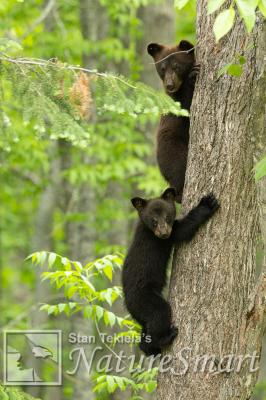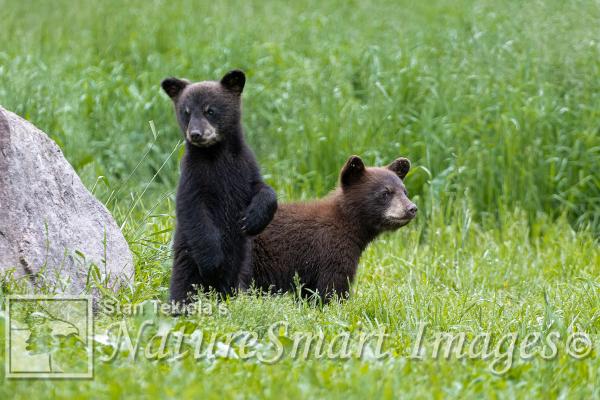View all of the titles in the
NatureSmart Bookstore


by Stan Tekiela
© NatureSmart
August 25, 2022
Last week while leading a wildlife photography workshop to capture images of American Black Bears (Ursus americanus) we experienced a cuteness overload. Over three and half days, we saw many mother bears with spring cubs. The term “spring cub” refers to cubs that were born this past winter and just now coming out of den with their mother.
We are extremely fortunate in North America to have 3 out of the 8 bear species in the world. These are the Polar Bear, Brown Bear and Black Bear. The Polar Bear occur in the far northern region of Canada and Alaska. There are many subspecies of the Brown Bear including the well know Kodiak Brown Bear which is the largest of the subspecies and the Grizzly which is the smallest.
The Black Bear is unique to North America. This is why they are usually called the American Black Bear. It is found all across Canada and Alaska and reaching down the Rocky Mountains and extending well into Mexico. They are also found in many of the central and eastern states and as far south as Florida.
My photographic group was thrilled to see so many young spring cubs. These tiny four-legged furry critters were born just 3 to 4 months ago, during the coldest part of winter (January and February) in a protected den shared by their mother. Amazingly the cubs where only 8 to 10 ounces (half a pound) at birth. This is a tiny fraction of the size of the mother who is 200 to 300 pounds.
The mother looks after and takes care of the small bears for about 17 months. However, at a one and a half year of age and not very full grown at all, the young bears are chased away (dispersed) by the mother in June and July of their first full year. The mating season for bears is in June / July and the mother can’t have young cubs around when the big male bears come around for mating.
Mother bears give birth to 1 to 6 young (average 2 to 3) every other year after they reach sexual maturity at 3 to 5 years of age. After mating the fertilized eggs do not implant in the female’s womb (uterus). The eggs are fertilized but remain in a suspended state and don’t grow until November when the eggs attach to the uteran wall.
So technically the gestation is only about 10 weeks long, which explains why the baby bears are so small at birth. Their eyes are still shut, and they are 100 percent dependent upon their mother. Their eyes don’t open until they are 30-40 days old and start to walk at 5 weeks. By the time the cubs follow the mother out of the den they weigh only about 4-8 pounds. They can run and climb trees to avoid danger even though they are so small. In fact, young bears spend more time up in trees than they do on the ground.
The cubs continue to nurse on mothers’ milk until their teeth grow in and they start to eat solid food. The cubs nurse for around 30 weeks. At 6 months of age, they weigh from 40-60 pounds and are eating fully on their own.
On average Black Bears live around 18 to 20 years and it’s hard to imagine that these tiny, super cute baby bears will grow up to be 300 pound males or 200 pound females. The oldest known Black Bear was a female that was over 39 years old and lived in the forests of northern Minnesota.
Over three days we had several opportunities to see and capture some amazing images of the spring cubs. Everything in the wild world is new and scarry to these tiny cubs so their natural response is to climb up a tree. Also, if the mother senses any danger she will huff and grunt, telling the cubs to get up in a tree. When this happened, it allowed us to capture some wonderful images and natural behaviors of these amazing critters. Until next time…
Stan Tekiela is a author / naturalist and wildlife photographer who travels the U.S. to study and photograph wildlife. He can be followed on Instagram, Facebook and Twitter. He can contacted via his web page at naturesmart.com.
The nationally syndicated NatureSmart Column appears in over 25 cities spanning 7 states: Minnesota, Wisconsin, Michigan, Illinois, Ohio, New York and Pennsylvania. It is a bi-weekly column circulated to over 750,000 readers.
Wolves
Just the day before, a pack of wolves known as the Wapiti, had found a large bull bison that was weak and injured. Based on its size, this big boy was near the end of its lifespan and the winter weather was taking its toll. For a full day the wolves tried to approach the bison but when the bison...
Moose
It was one of those dark and cloudy winter days in Yellowstone National Park where the clouds are so heavy and low, you feel like you can reach up and touch the cloudy sky. A light wind helped to blow the falling snow with occasional gusts of wind causing swirls of fluffy white snow...
American Badger
It’s funny, I believe the average person knows more about the Honey Badger (Mellivora capensis), a critter of Africa and Southwest Asia than they do about the badger in our own backyard, the American Badger (Taxidea taxus). Social media has a lot to do with the Honey Badger phenomena and...
Backyard Bird Feeding
Winter bird feeding is one of the most common / popular hobbies in America. It is estimated that nearly 60 million Americans feed birds in their yards in winter or summer. That is about 40 percent of all American’s make backyard bird feeding part of their everyday activities. It’s...
Each year, during June and July, Stan Tekiela offers two world-class wildlife photography tours. Here's your chance to learn some tricks of the trade from a top professional.
View all of the titles in the
NatureSmart Bookstore
Check out Stan's latest photos at
NatureSmart Wildlife Images
Do you have any interesting wildlife in your backyard? Any nesting birds, deer, turkeys, reptiles, amphibians, or other unique wildlife? Or maybe a fox or coyote den?
If so, contact Stan at stan@naturesmart.com with your backyard wildlife. If he can get a good photo of the subject, he will send you a print of the photo to hang on your wall.
Order Prints and posters of Stan's photos at
» Prints & Posters
Hear Stan on radio stations all across the Midwest.
» More Info

When he's out in the field, Stan relies on his Vortex Razor binoculars and Vortex Razor spotting scope to help find the subjects for his award winning wildlife photography.

For thirty years, professional wildlife photographer Stan Tekiela has counted on Hunt's Photo and Video to provide him with professional photography equipment.
From tripods to camera bodies and lenses, Hunt's has been Stan's place for everything that he needs. Personal service and prompt shipping means Stan can count on Hunt's to support his professional wildlife photography career.


Professional Wildlife Photographer Stan Tekiela always uses Feeder Fresh in his seed feeders to help keep the feeders and food dry, clean and mold free.
He also uses Feeder Fresh Nectar Defender in all of his hummingbird feeders. It safely keeps nectar fresh longer.